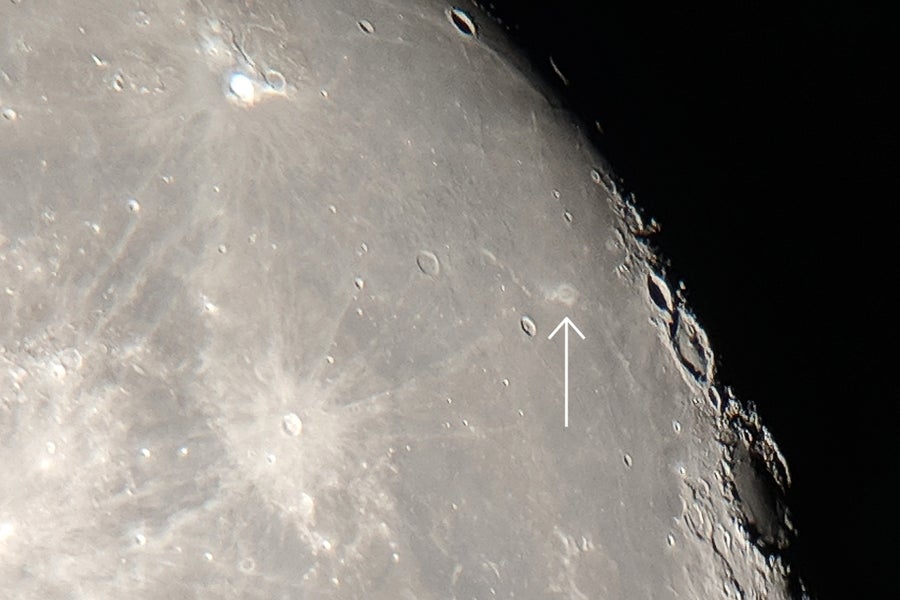For centuries, a mystery has been hiding in plain sight on the surface of the moon: bright, sinuous swirls that sprawl across thousands of square kilometers of the lunar landscape, visible through telescopes on Earth but defying explanation. Now, at last, scientists are starting to understand them—and it turns out they’re weirder than anyone would have imagined. These enigmatic “lunar swirls” are the result of ancient underground force fields that shield the moon from barrages of subatomic particles blasted out by the sun. Each swirl is a meandering blanket of pristine rock interlaced with darkened, radiation-zapped material.
While most of the moon’s features are sharp and rugged, lunar swirls are instead smooth and wispy, like cirrus clouds painted on the surface. They’re widespread, too; some appear in Mare Marginis (Latin for the “Sea at the Edge,” because from Earth, it appears on the very eastern edge of the moon’s face), while another, Reiner Gamma, lies thousands of kilometers westward. They’re seen both in the smooth, dark lowland maria (Latin for “seas,” which is what they vaguely resemble to the earthbound unaided eye) and in the heavily cratered highlands, suggesting they aren’t associated with any particular feature. As they are brighter than the dark maria—which are plains of dark flooded basaltic lava—lunar swirls are easier to spot in those regions.
Observers realized long ago that the swirls cast no shadows, so they can’t be topographic features like hills or valleys. Instead they resemble what you’d get if clouds collapsed on the surface—although without an appreciable atmosphere, that’s not possible on the moon. And even if such a “cloud collapse” were possible there, more recent observations of the lunar swirls indicate they’re made of the same material as their surroundings—they’re not overlain matter but rather very much a part of the preexisting surface.
On supporting science journalism
If you’re enjoying this article, consider supporting our award-winning journalism by subscribing. By purchasing a subscription you are helping to ensure the future of impactful stories about the discoveries and ideas shaping our world today.
Reiner Gamma is one of the largest and most well-studied lunar swirls; a flattened oval like a staring eye over 100 kilometers wide, with two long wispy tails extending from either end for hundreds more. That makes it big enough to see even in small telescopes, and in fact I’ve seen it with my own! I was amazed at the time that a feature so lovely and conspicuous could still be eluding explanation.

A photograph showing Reiner Gamma, a “lunar swirl” near the moon’s right edge. It was taken using a 20-cm telescope and a phone camera.
Lunar swirls’ remarkable brightness, it turns out, is a crucial clue to explaining what they are and where they came from. Material on the surface darkens over time as radiation from the sun beats down on it. A rule of thumb is that anything on the moon that’s brighter is younger. For example, look at the brilliant, feathery “rays” of relatively fresh material that is splashed out around giant craters such as Tycho, which formed circa 100 million years ago. That’s practically yesterday in lunar terms because the moon’s surface is billions of years old and essentially static compared with Earth’s!
During the Apollo era, scientists speculated the swirls could be material spewed out by recent volcanism. But maps of the moon’s magnetic field (made using data from Apollo 15 and 16) showed that the swirls all coincided with regions of slightly stronger magnetism, indicating a different and more complicated origin. Understanding how this relates to their brightness requires a quick foray into lunar history and the geophysics of magnetic fields.
Unlike Earth, the moon today doesn’t have a global magnetic field. It had a weak one billions of years ago, when it was still molten, but that died down quickly as the moon cooled. As rocks solidified on the surface, however, they were able to retain some of that ephemeral magnetism, creating more enduring localized regions with a somewhat stronger magnetic field. Given their ancient origin, these are called “relic” fields, and many are associated with lunar swirls.
The actual reason for this association became clear about a decade ago, when scientists published results in Nature Communications that showed that the relic fields around swirls, weak as they are, can still be strong enough to slightly deflect the solar wind impinging on the lunar surface. This wind consists of subatomic particles from the sun, and the trajectories of electrically charged particles such as electrons and protons can be changed by magnetic fields. Where the relic fields are stronger, the particles veer off to the side, darkening the ground where they fall—and leaving curiously curlicue patterns in the more pristine magnetically shielded surface.
So surprisingly the lunar rule of thumb of “brighter” meaning “younger” isn’t always true. Sometimes “brighter” instead means something is avoiding the aging effects of cosmic radiation.
I remember reading that research paper with delight, a growing grin on my face. The Star Trek fan in me was overjoyed: lunar swirls exist because our moon had deflector shields—force fields!
You might now wonder: Sure, the swirls are magnetic in nature. But why are they long and sinuous? In 2018 more research showed that the source of the magnetic fields making the swirls must be shallow, less than three kilometers under the surface. This suggests the swirls are tracing buried geological features formed from ancient lunar volcanism: lava tubes, rilles and dikes. Rilles are long, shallow gullies carved by flowing lava. Sometimes, as it cools, the flowing lava makes an overlying roof of solid rock, forming a subsurface lava tube. Some swirls are found near lava tubes: Mare Ingenii (“Sea of Cleverness”) has swirls and pits in the surface that indicate lava tubes beneath. Dikes are geological features where magma intrudes and cools between preexisting layers of rock, creating enormous sheetlike structures.
If the rock in such structures has a relic magnetic field, it can create swirls on the surface. In 2024 a team of scientists published a paper in Journal of Geophysical Research: Planets showing that deposits of ilmenite, a mineral common in lunar magma, could enhance the local abundance of elements such as iron and nickel in dikes, amplifying the amount of magnetism there.
While this paints a good overall picture of the swirls and how they formed, unanswered questions remain, of course. Another paper published in the Planetary Science Journal indicates that there is some topographical variation in swirls; on average, the brighter regions of swirls tend to be a few meters lower in elevation than the dark areas. It’s not yet clear why this might be, and in their paper, the scientists note that the ultimate source of the discoloration hasn’t been conclusively determined. Although the solar wind remains a strong candidate, other models propose that the differential coloration comes from material scattered by comets or static-electricity-charged dust grains lofted by tiny micrometeorite impacts, either of which would then be sorted by the moon’s relic magnetic fields.
To me, the real message of the lunar swirls’ complex origin story is quite simple: the moon is literally the closest celestial object to Earth in the entire universe, yet there’s still so much of it we don’t understand. That is a cause for excitement, not dismay. As we explore the moon in more detail—possibly even in person, building on our first forays there more than a half-century ago—we’ll get a chance to solve more of its mysteries, including those that perplex us right out in the open.


